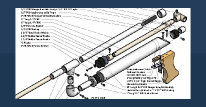
Help with springs
#1

Posted 15 November 2013 - 11:28 PM
I know that using a stronger spring than a [k26] can sometimes really hurt people. And surprisingly I don't want to do that.
I would like a 4 or 5 inch draw; anyone have any suggestions on how I can select the right spring?
Please feel free to call me an idiot if I have looked this over
I also know that there must be some equation I can use to calculate this, but I am not sure if I could use it only having a high school education!
Thanks in advance
#2

Posted 16 November 2013 - 01:28 AM
Alright let me just ask this question right off the bat, how do I get similar power of a [k26] fully compressed on a smaller scale? That meaning, I want less draw same power.
I know that using a stronger spring than a [k26] can sometimes really hurt people. And surprisingly I don't want to do that.
I would like a 4 or 5 inch draw; anyone have any suggestions on how I can select the right spring?
Please feel free to call me an idiot if I have looked this over
I also know that there must be some equation I can use to calculate this, but I am not sure if I could use it only having a high school education!
Thanks in advance
Any length of [k26] will produce the same amount of power when fully compressed. 4-5'' of draw requires a 6-7'' [k26].
~T
#3

Posted 17 November 2013 - 12:02 AM
Any length of [k26] will produce the same amount of power when fully compressed. 4-5'' of draw requires a 6-7'' [k26].
~T
Edited by roboman, 17 November 2013 - 12:09 PM.
Youtube
LS and Retaliator boltsleds are currently available at https://www.facebook.com/RoboM8/
#4

Posted 17 November 2013 - 03:35 AM
Nope. Springs follow Hooke's Law, which states F=kx, where F is the force exerted, k is the spring constant, and x is the spring deflection. Full compression on a 6-7" long [k26] will not give you a force of 32 lbs. This thread discusses how to determine the force exerted by a shortened spring (since shortening the spring changes the k constant), using the constant that McMaster gives you (which is not the same as the k constant in Hooke's Law).
What you have to realize is that k changes when you change the free length. The force at full compression of a spring is directly proportional to the ratio between the free length and the active coils. Cutting down a spring doesn't change this ratio, so you get the same max load for all lengths. See this thread I started a while back.
~T
#5

Posted 17 November 2013 - 12:09 PM
What you have to realize is that k changes when you change the free length. The force at full compression of a spring is directly proportional to the ratio between the free length and the active coils. Cutting down a spring doesn't change this ratio, so you get the same max load for all lengths. See this thread I started a while back.
~T
Note that I did actually mention that, and that the second half of my response discussed that. I did not realize that it was directly proportional, though.
EDIT: It has been brought to my attention that OP was looking for power, not force. Power is force over a period of time (or the integral of force with respect to time), so a shortened [k26] will not exert the same amount of power, though it does have the same maximum load when fully compressed. It would not be terribly difficult to find the necessary spring to get the equivalent power of a [k26] with a shorter stroke if you know all of the forces acting in opposition to the spring (friction, inertia, etc.), or the velocity curve of the plunger as it travels through the plunger tube. You would, of course, also need to factor in the reduced air volume produced by a shorter draw, assuming that the plunger tube ID remains the same. So no, to answer one of your actual questions, it's not particularly easy to work that out.
Edited by roboman, 17 November 2013 - 05:17 PM.
Youtube
LS and Retaliator boltsleds are currently available at https://www.facebook.com/RoboM8/
#6

Posted 18 November 2013 - 12:03 AM
Note that I did actually mention that, and that the second half of my response discussed that. I did not realize that it was directly proportional, though.
EDIT: It has been brought to my attention that OP was looking for power, not force. Power is force over a period of time (or the integral of force with respect to time), so a shortened [k26] will not exert the same amount of power, though it does have the same maximum load when fully compressed. It would not be terribly difficult to find the necessary spring to get the equivalent power of a [k26] with a shorter stroke if you know all of the forces acting in opposition to the spring (friction, inertia, etc.), or the velocity curve of the plunger as it travels through the plunger tube. You would, of course, also need to factor in the reduced air volume produced by a shorter draw, assuming that the plunger tube ID remains the same. So no, to answer one of your actual questions, it's not particularly easy to work that out.
Thanks man, I guess I may have to experiment a little before using it in a war. I may just shorten the [k26] but increase the volume by let's say a 1/4 inch more than what I was using before.
#7

Posted 18 November 2013 - 01:47 AM
[15:51] <+Rhadamanthys> titties
[15:51] <+jakejagan> titties
[15:51] <+Lucian> boobs
[15:51] <+Gears> titties
[15:51] <@Draconis> Titties.
[15:52] <+Noodle> why is this so hard?
#8

Posted 18 November 2013 - 11:18 AM
Also for the sake of discussion it can hit ~100' with the half [k25]; that's about 15 feet less than the HEC 1 which has a full [k26] (hits ~120). Our blasters are basically more powerful than they need to be; half the spring still gets 83% of the range.
So you should probably just make a blaster with a shorter draw length and see what happens.
The reason the draw length stops mattering is that you're not able to make use of the extra energy the blaster imparts on the dart. Whether it's because of inefficiencies in the system or just a limitation of the darts we're using, at some point you can't put more power behind a dart and get it to fly further.
#9

Posted 18 November 2013 - 11:56 AM
The power the blaster provides arguably doesn't matter past a certain point - atomatron's comments on his HEC 3 Half-Pump
The reason the draw length stops mattering is that you're not able to make use of the extra energy the blaster imparts on the dart. Whether it's because of inefficiencies in the system or just a limitation of the darts we're using, at some point you can't put more power behind a dart and get it to fly further.
For single shot blasters, this is basically true. My half-length Rainbow shoots about 230 ft/s (3.5" of draw) vs 250 ft/s from my full-sized rainbow (7" draw). Half length springs double their spring constant, so the spring pushes with just as much force as the full sized configuration. The blaster has the same amount of Power, but does less Work because of the shortened draw. For single shots, the dart leaves the barrel before the plunger has traveled all the way through the tube, so a lot of potential is wasted. The extra volume delivered by a full-sized plunger tube is useful when using hoppers; with tons of excess air volume, it doesn't matter if your dart isn't seated well, it will just HULK SMASH the dart into the barrel. But if you're using a speedloader, that extra 3" of plunger draw isn't doing a whole lot for ya.
So... to answer the OP's question:
Cut a [k26] in half and make a half-length SNAP with 3.5" of draw and a 12" barrel. It will shoot about 90% as far as a full-sized SNAP when using a speedloader. It will shoot maybe 70% as far with a hopper and a shortened barrel. If you want to dial down the power a bit, use a [k25] spring or use 3" of draw instead.Alright let me just ask this question right off the bat, how do I get similar power of a [k26] fully compressed on a smaller scale? That meaning, I want less draw same power.
Edited by Daniel Beaver, 18 November 2013 - 12:01 PM.
#10

Posted 18 November 2013 - 03:38 PM
For single shot blasters, this is basically true. My half-length Rainbow shoots about 230 ft/s (3.5" of draw) vs 250 ft/s from my full-sized rainbow (7" draw). Half length springs double their spring constant, so the spring pushes with just as much force as the full sized configuration. The blaster has the same amount of Power, but does less Work because of the shortened draw. For single shots, the dart leaves the barrel before the plunger has traveled all the way through the tube, so a lot of potential is wasted. The extra volume delivered by a full-sized plunger tube is useful when using hoppers; with tons of excess air volume, it doesn't matter if your dart isn't seated well, it will just HULK SMASH the dart into the barrel. But if you're using a speedloader, that extra 3" of plunger draw isn't doing a whole lot for ya.
So... to answer the OP's question:
Cut a [k26] in half and make a half-length SNAP with 3.5" of draw and a 12" barrel. It will shoot about 90% as far as a full-sized SNAP when using a speedloader. It will shoot maybe 70% as far with a hopper and a shortened barrel. If you want to dial down the power a bit, use a [k25] spring or use 3" of draw instead.
Now I feel more confident! Il let you guys know how it goes. I just want to make a compact without sacrificing to much from a regular sized homemade
1 user(s) are reading this topic
0 members, 1 guests, 0 anonymous users














